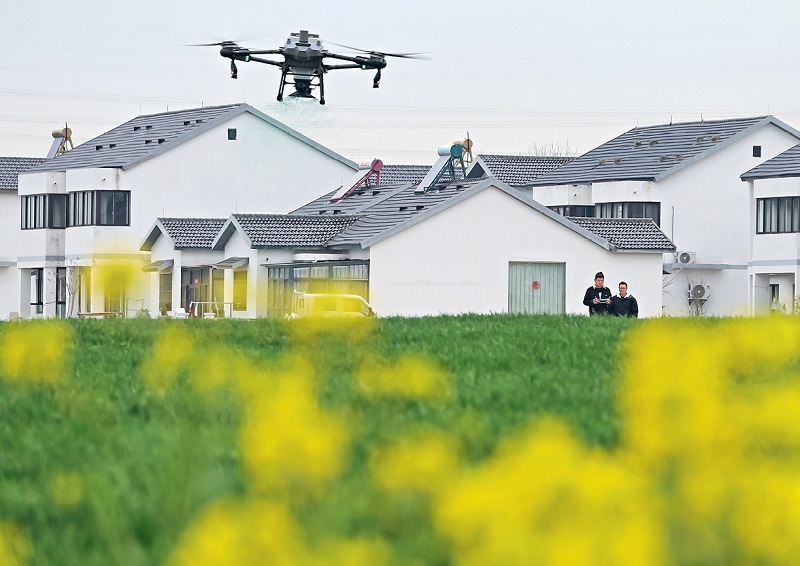Despite disruptions by protectionist policies, the "two sessions” championed the concept of a global community of shared future.

Farmers operate a drone to fertilize wheat fields in Hezhuang, a village in Zhenjiang City, Jiangsu Province, on March 14, 2025.
The effects of this year’s “two sessions” will go beyond the five percent annual GDP growth projected for 2025 during the event.
Chinese President Xi Jinping stressed the important role of scientific and technological innovation and education in promoting national development at a deliberation with lawmakers from east China’s Jiangsu Province on March 5. This commitment is important for the international community as well amid the challenges it is facing.
During the meeting, the technological breakthroughs achieved over the last 12 months were highlighted, reflecting not just China’s technological self-reliance but its capability to lead in global innovation. For example, the Chang’e-6 probe achieved a historic milestone in human space exploration by bringing samples from the moon’s far side; open-source AI model DeepSeek R1 demonstrated China’s ability to develop cutting-edge technology; and the commercial voyage of Adora Magic City, China’s first domestically-built large cruise ship, reflected the country's leap-frog advancements in high-end manufacturing.
This was Xi’s meeting with Jiangsu deputies during the National People’s Congress session for the third consecutive year. There are plenty of reasons for this. The province has a strategic location neighboring Shanghai, a high GDP that ranks second in China after Guangdong Province in the south, and a high economic growth of 5.8 percent in 2024. It is also a manufacturing powerhouse, ranking first in the nation for manufacturing value added.
Jiangsu’s sci-tech industry shows great strength, with over 57,000 hi-tech enterprises. Also, the province has the highest number of China’s newly added unicorn and potential unicorn companies. A unicorn company is a privately held startup valued at over $1 billion.
Amidst global economic uncertainties, the “two sessions” emphasized Jiangsu’s success as a model for the nation’s broader modernization efforts. The province’s achievements in high-quality manufacturing and robust innovation ecosystem underscore its potential to drive both regional and national progress. All this makes Jiangsu highly promising for foreign innovators seeking synergies in China's evolving economic landscape.
Education is one of the factors explaining these remarkable results. Over a decade, 15-year-old students in Beijing, Shanghai, Jiangsu and Zhejiang ranked first in reading, mathematics, and science in an assessment for international students coordinated by the Organisation for Economic Co-operation and Development (OECD). This highlights China’s advancement in education, particularly given that the four Chinese regions’ average household income was below the OECD average.
During a meeting with political advisors, Xi highlighted the critical role of education in supporting scientific advancement and talent development. The government’s strategic priorities include deepening reform in education, optimizing resource allocation, and fostering a “talent-first” ecosystem.
Over the past decade, China has emerged as a global leader in innovation, with its annual number of engineering graduates surpassing the combined totals of the U.S. and Europe. This trajectory of growth is mirrored by its patent filings. According to the World Intellectual Property Organization, in 2023, China submitted 1.64 million patent applications, while the U.S. filed 518,364. This represents a dramatic shift from two decades earlier, when China’s patent filings were a fraction of those in the U.S. and Japan, and lagged behind Europe and South Korea.
The government work report presented at this year’s “two sessions” said emerging, future-oriented industries, such as biomanufacturing, quantum technology, embodied Artificial Intelligence (AI), and 6G technology, will be reinforced. A mechanism will be established to increase funding for them. High-quality development of key manufacturing chains and re-engineering the industrial foundation are other goals.
Large-scale AI models will be applied extensively. There are two reasons for China’s proficiency in hi-tech innovations. As early as in 2017, China announced the goal of becoming a world leader in AI by 2030. My own personal experience after studying and working in China and monitoring the country’s development since then tells me that middle- and long-term plans in China matter more than in any other major country.
Huawei (which has improved the quality of domestic and international communications), Alibaba (with its sales platform and AI), TikTok (opening up a new world of experiences for countless creators and small, medium, and big entrepreneurs), and the recent DeepSeek (with its open source AI and management model offering unlimited opportunities) are some examples of Chinese technology companies combining private initiative with official support to produce results the world has been marveling at.
According to the China Internet Network Information Center, Internet penetration in China reached 78.6 percent in 2024, just three decades after the country was fully connected. Communications theorist Marshall McLuhan, who coined the concept “global village,” would have been amazed at what China has achieved. But then, this is the nation that invented paper, printing, the compass, gunpowder, and even the locking technique that centuries later was used in the construction of the Panama Canal.
The famous statement by Neil Armstrong, the first astronaut to set foot on the moon, “One small step for man, one giant leap for mankind,” can be used to understand Chinese current disruptive innovations as well.
The trajectory of human progress hinges on collaborative efforts. Despite disruptions by protectionist policies, innovators, institutions, and nations are likely to advance the vision of a “global community of shared future” championed by China for mutual benefits, equity, and justice in global affairs. The global common challenges require countries to transcend protectionism. With new hi-tech tools at hand, we need more concerted international will, not new expansionism and senseless tariffs, to talk, dynamically negotiate, and reinforce both development and multilateralism. 
AUGUSTO SOTO is director of the Spain-based Dialogue with China Project.